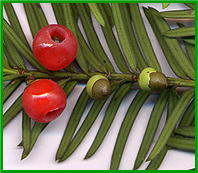by Dr. Christina Wilson, Head of Toxicology/Analytical Chemistry
and Kimberly Meyerholtz, Assistant Chemist
 Yews (Taxus spp.) are evergreen plants commonly used for ornamental landscaping throughout the Midwest. The most common varieties of this plant that are found in Indiana include English yew (Taxus baccata), Japanese Yew (Taxus cuspidata) and Canada Yew (Taxus canadensis). These plants can be highly toxic and have been implicated in numerous animal and livestock poisonings. In the majority of the clinical cases reported, yew poisoning is frequently due to accidental exposure as a result of animals being unwittingly fed clippings from yew bushes. In a 500 pound animal, it may take as little as 0.5 pounds of yew clippings to be potentially fatal.
Yews (Taxus spp.) are evergreen plants commonly used for ornamental landscaping throughout the Midwest. The most common varieties of this plant that are found in Indiana include English yew (Taxus baccata), Japanese Yew (Taxus cuspidata) and Canada Yew (Taxus canadensis). These plants can be highly toxic and have been implicated in numerous animal and livestock poisonings. In the majority of the clinical cases reported, yew poisoning is frequently due to accidental exposure as a result of animals being unwittingly fed clippings from yew bushes. In a 500 pound animal, it may take as little as 0.5 pounds of yew clippings to be potentially fatal.
The poisonous nature of the yew plant is attributed to the presence of cardiotoxic taxine alkaloids, which are present in the leaves, bark, and seeds of the plant. Toxic amounts of these alkaloids remain in the plant throughout the year and are not significantly degraded or decreased by drying. These toxins cause cardiac dysrhythmias and a rapid onset of clinical signs. Clinical signs in animals can vary depending on the amount of yew ingested. However, in most cases of yew poisoning, animals are often found dead in 24 hours or less after ingestion without showing adverse clinical signs of toxicity. Other clinical signs that may be observed can include ataxia, bradycardia, dyspnea, muscle tremors, recumbency, and convulsions leading to collapse and death.
Diagnosis of yew poisoning is primarily based on history of exposure or macroscopic identification of yew plant fragments in the stomach, rumen, or other parts of the digestive tract. The Toxicology Section of the Indiana Animal Disease Diagnostic Laboratory handles several cases of yew poisoning each year. In most of these cases, livestock deaths could have been prevented had the animals not been given access to the plant. Therefore, ensuring that animals and livestock do not have access to yew clippings or plants is vital.